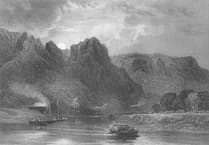THE new £20 note unveiled last week by the Bank of England includes a link to Tintern Abbey.
It features the artist JMW Turner and includes a small image of a see-through window inspired by his painting of the abbey.
Turner visted the Wye Valley and sketched Tintern Abbey in 1792, before producing his painting Tintern Abbey: The Crossing and Chancel, Looking towards the East Window two years later, exactly 225 years ago.
Bank of England Governor Mark Carney officially unveiled the design of the new £20 note featuring Turner, which will be issued for the first time on February 20, 2020.
The polymer £20 note contains sophisticated security features making it the most secure Bank of England banknote yet, said a spokesperson.
For the first time, the note incorporates two windows and a two-colour foil, making it very difficult to counterfeit.
The Governor said: “Our banknotes celebrate the UK’s heritage, salute its culture, and testify to the achievements of its most notable individuals.
“And so it is with the new £20 banknote, featuring JMW Turner, launched today at Turner Contemporary in Margate.
“Turner’s contribution to art extends well beyond his favourite stretch of shoreline. Turner’s painting was transformative, his influence spanned lifetimes, and his legacy endures today.
“The new £20 note celebrates Turner, his art and his legacy in all their radiant, colourful, evocative glory.”
The new note, like the polymer £10, will contain a tactile feature to help vision impaired people identify the denomination.
It will join the Churchill £5 and the Austen £10, and a new £50 note, featuring Enigma codebreaker and computer inventor Alan Turing, will follow in 2021.
The public can continue to spend paper £20 notes as usual and these will be gradually withdrawn as they are banked by retailers and the public.
Notice will be given six months ahead of legal tender status of the paper £20 being withdrawn.
The new £20 note will be the first to feature the signature of Sarah John, the Bank’s new Chief Cashier.
She said: “The new £20 is an important part of our commitment to providing banknotes that people can use with confidence.
“Our polymer notes are much harder to counterfeit and, with the £20 being our most common note, this marks a big step forward in our fight against counterfeiting.
“I hope the public will look forward to spending their new Turner £20s from February next year.”
As well as the Tintern window, a second larger see-through window with blue and gold foil on the front depicts Margate lighthouse and Turner Contemporary.
The foil is silver on the back. The shape of the large window is based on the shape of the fountains in Trafalgar Square.
The note also includes JMW Turner’s self-portrait, painted around 1799 and currently on display in Tate Britain, one of Turner’s most eminent paintings The Fighting Temeraire, a tribute to the ship which played a key role in Nelson’s victory at the Battle of Trafalgar in 1805, and a metallic hologram which changes between the word ‘Twenty’ and ‘Pounds’ when the note is tilted.
Other features include the Queen’s portrait, a silver foil patch with a 3D image of the coronation crown, a purple foil patch containing the letter ‘T’ and based on the staircase at the Tate Britain, the quote “Light is therefore colour” from an 1818 lecture by Turner, and the artist’s signature from his will, which bequeathed many of his paintings to the nation.




